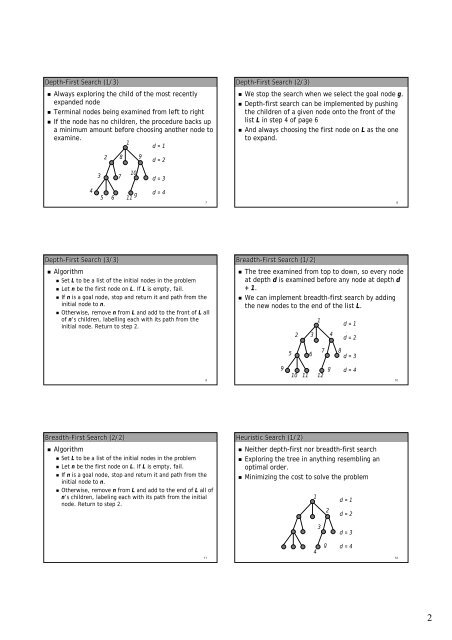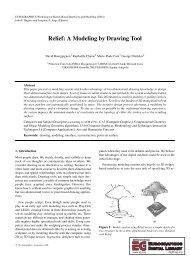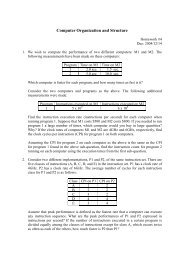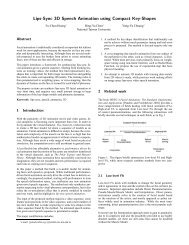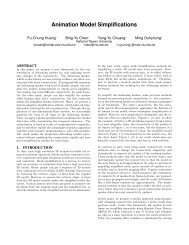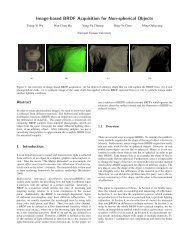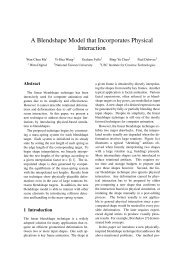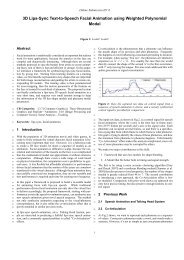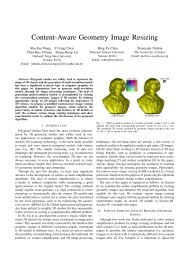pdf(for print) - Computer Graphics Laboratory
pdf(for print) - Computer Graphics Laboratory
pdf(for print) - Computer Graphics Laboratory
Create successful ePaper yourself
Turn your PDF publications into a flip-book with our unique Google optimized e-Paper software.
Depth-First Search (1/3)<br />
• Always exploring the child of the most recently<br />
expanded node<br />
• Terminal nodes being examined from left to right<br />
• If the node has no children, the procedure backs up<br />
a minimum amount be<strong>for</strong>e choosing another node to<br />
examine.<br />
1<br />
d = 1<br />
2 8 9<br />
d = 2<br />
Depth-First Search (2/3)<br />
• We stop the search when we select the goal node g.<br />
• Depth-first search can be implemented by pushing<br />
the children of a given node onto the front of the<br />
list L in step 4 of page 6<br />
• And always choosing the first node on L as the one<br />
to expand.<br />
3<br />
7<br />
10<br />
d = 3<br />
4<br />
5 6<br />
g<br />
11<br />
d = 4<br />
7<br />
8<br />
Depth-First Search (3/3)<br />
• Algorithm<br />
• Set L to be a list of the initial nodes in the problem<br />
• Let n be the first node on L. . If L is empty, fail.<br />
• If n is a goal node, stop and return it and path from the<br />
initial node to n.<br />
• Otherwise, remove n from L and add to the front of L all<br />
of n’s children, labelling each with its path from the<br />
initial node. Return to step 2.<br />
Breadth-First Search (1/2)<br />
• The tree examined from top to down, so every node<br />
at depth d is examined be<strong>for</strong>e any node at depth d<br />
+ 1. 1<br />
• We can implement breadth-first search by adding<br />
the new nodes to the end of the list L.<br />
1<br />
2 3 4<br />
d = 1<br />
d = 2<br />
5<br />
6<br />
7<br />
8<br />
d = 3<br />
9<br />
9<br />
10 11<br />
12<br />
g<br />
d = 4<br />
10<br />
Breadth-First Search (2/2)<br />
• Algorithm<br />
• Set L to be a list of the initial nodes in the problem<br />
• Let n be the first node on L. . If L is empty, fail.<br />
• If n is a goal node, stop and return it and path from the<br />
initial node to n.<br />
• Otherwise, remove n from L and add to the end of L all of<br />
n’s children, labeling each with its path from the initial<br />
node. Return to step 2.<br />
Heuristic Search (1/2)<br />
• Neither depth-first nor breadth-first search<br />
• Exploring the tree in anything resembling an<br />
optimal order.<br />
• Minimizing the cost to solve the problem<br />
1<br />
2<br />
d = 1<br />
d = 2<br />
3<br />
d = 3<br />
11<br />
4<br />
g<br />
d = 4<br />
12<br />
2


